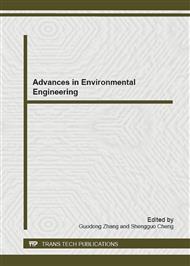p.344
p.348
p.354
p.358
p.363
p.367
p.372
p.378
p.383
Lab-Scale Study on Removal of Phenol from Contaminated Groundwater by Chlorine Dioxide Oxidation Technology
Abstract:
A series of experiments were conducted to investigate the optimal technical parameters for phenol removal by chlorine dioxide (ClO2) oxidation. Results demonstrated that ClO2 could removal phenol effectively, both for simulated phenol contaminated groundwater and practical phenol contaminated groundwater. ClO2 dosage and reaction time were found to have a significant impact on phenol removal, while pH only affected slightly between 6.5 to 7.0 . Under optimal reaction conditions, the removal rate could reach an extremely high level of 97.5% within 30 min at a ClO2 dosage of 0.6 mg/L for the simulated phenol contaminated groundwater with initial phenol concentration of 0.2 mg/L. For the practical phenol contaminated groundwater the removal rate could reach 96% within 60 min at a ClO2 dosage 1.0 mg/L. This study provides a feasible chemical method to removal phenol from contaminated groundwater.
Info:
Periodical:
Pages:
363-366
Citation:
Online since:
November 2012
Authors:
Keywords:
Price:
Сopyright:
© 2012 Trans Tech Publications Ltd. All Rights Reserved
Share:
Citation:


